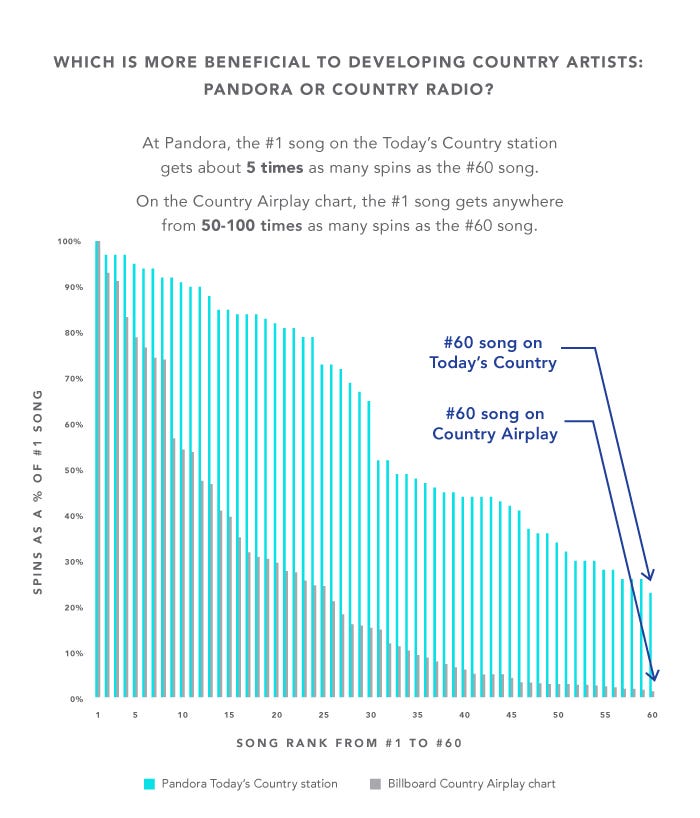Beers, Blue Jeans, And Broadcast Radio vs. Pandora
For all the criticism leveled at Pandora of late, it seem the popular internet radio service is helping out some mid-tier musicians, or at least those who play country music, by providing them with significantly greater airtime than traditional broadcast radio.
_________________________________
Guest post by Glenn Peoples, Music Insights and Analytics at Pandora
Pandora has long said its Internet radio service is good for artists. Listeners can decide what they do and do not hear by “thumbing” songs. A listener won’t hear a song given a “thumb down.” A “thumb up” for positive feedback tells Pandora to play that song and more like it. Personalized Internet radio is democratic like that.
Don’t get lost in the numbers. Just know that traditional country radio can be very powerful to a handful of stars while Pandora provides more opportunity for a larger number of country artists to get heard. In fact, the Pandora’s Today’s Country station [consistently one of the top stations at Pandora, by the way] can deliver to a developing or mid-tier artist up to 14x times the audience share they would have on the country airplay chart.
There are numbers that back up this notion that Pandora is an audience engine for developing artists. Pandora is fair and beneficial simply because less popular artists have as much opportunity on Pandora as superstars. Broadcast country radio is far more slanted toward a handful of artists.
My comparison began at the audience numbers on Billboard’s Country Airplay chart. The chart, published in Billboard’s weekly Country Update, ranks the week’s top 60 songs and gives both the number of spins and the total audience at the country stations tracked by Nielsen Music. The top song on the May 16 Country Airplay chart was Dierks Bentley’s “Somewhere on a Beach” with an audience of 49.2 million, a typical number for a top song on that chart. The #60 position had just 1.5 percent the audience as “Somewhere on a Beach.” In contrast, on Pandora’s analogous Today’s Country station, the #60 song had 21 percent the audience as the #1 song, David Nail’s “Night’s on Fire” — over 14x better than same spot on the Country Airplay chart. [The re-current songs that probably dropped off the Country Airplay were removed from the Today’s Country numbers. This was done to create a good apples-to-apples comparison. The Country Airplay chart includes new and current songs, not re-current songs.]
Next, I compared the audience share of 12 songs that had the same or nearly the same rankings. A song was selected if its Today’s Country rank was within two or three spots from the Country Airplay rank. For example, Old Dominion’s “Snapback” is #4 Today’s Country Rank and #3 rank on Country Airplay. In these 12 songs I examined, the difference in shares were substantial and could exceed as many as 50 percentage points. Canaan Smith’s “Hole in a Bottle” is a good example of Pandora’s benefit to developing artists. “Hole in a Bottle,” ranked #24 on Today’s Country and#23 on Country Airplay, had a 79-percent share at the Pandora station compared to a 26-percent share on country radio — a 53-percentage point difference. Jordan Rager’s “Southern Boy,” hovering around #50, has a similar story. It has a 35-percent share at Today’s Country and a 3-percent share at country radio. Put another way, “Hole in a Bottle” is getting buried under the hits at country radio but is grabbing a far better share of listening at Pandora.
The bottom line: if you’re not one of a handful of top artists, or if you’re trying to push a song up the charts, you’ll have a tough uphill climb at broadcast country radio. An artist whose song is #60 on the Airplay Chart is typically an artist that’s trying desperately to move up. It’s a winner-take-all market in which a very small number of songs grab most of the spins. In contrast, Pandora creates a more meaningful audience for a significantly larger number of songs.
Nice one.